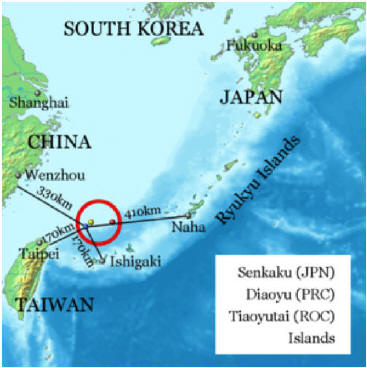Air Space
Ralph Murphy
(12/2013) Recent turmoil over China's decision to enforce international flight restrictions over territory it claims in the East China Sea appears to be the result of a 1994 Law of the Sea proclamation. It has been in contention since inception. Air space based on the disputed maritime boundaries, has now become an issue after Beijing inexplicably
chose to raise the threat level over what had ostensibly been a marginalized concern.
 A 1982 United Nations Convention on the Law of the Sea treaty (UNCLOS) regarding Exclusive Economic Zones (EEZ's) upheld in a 1994 Hague effort, was interpreted differently by the People’s Republic of China (PRC) and Japan. China claimed sovereignty into the East China Sea from its continental
shelf to include the Diaoyu islands (Senkaku in Japanese). Japan claimed an EEZ from its shoreline- a definition consistent with most international law. The maritime boundaries of the disputed islands lay within an overlap area- as has contested air space in the area. This has drawn in South Korea, and the United States which recently sent unarmed bombers over the region in
solidarity with Japan. South Korea sent a fighter escort, which was trailed by the North Koreans.
A 1982 United Nations Convention on the Law of the Sea treaty (UNCLOS) regarding Exclusive Economic Zones (EEZ's) upheld in a 1994 Hague effort, was interpreted differently by the People’s Republic of China (PRC) and Japan. China claimed sovereignty into the East China Sea from its continental
shelf to include the Diaoyu islands (Senkaku in Japanese). Japan claimed an EEZ from its shoreline- a definition consistent with most international law. The maritime boundaries of the disputed islands lay within an overlap area- as has contested air space in the area. This has drawn in South Korea, and the United States which recently sent unarmed bombers over the region in
solidarity with Japan. South Korea sent a fighter escort, which was trailed by the North Koreans.
This is not the first time this region has been in dispute. But, Beijing has escalated tensions dramatically with its insistence that any non-commercial planes flying over the area identify themselves to PRC authorities. As of this writing- it's any plane, and the US has agreed. Japan has disagreed. China also wants the planes to maintain radio contact
with the mainland. If they don't- they are in danger of being shot down.
The current dispute also has economic dimensions. The islands are known as good fishing grounds and also, for their natural gas reserves. A spat over the islands in 2010 resulted in a one- month trade loss. The conflict became more intense last year, when the Japanese government gave Japanese real estate developer Kunioki Kurihara $23 million dollars
for three of the largely, uninhabitable islands. Communist Party head Xi Jinping called the deal a farce. A costly trade war then erupted between the world's second and third largest economies.
China and Japan combined for $334 billion dollars in joint trade in 2012. That dropped to $147 billion dollars in the first half of 2013- drop of 10.8 percent. The Chinese have an aversion to Japanese products because of the East China Sea crisis. They go to the extreme of avoiding South Korean, supplied parts for Japanese products. The current
standoff will likely intensify the deteriorating trade relations between the two Pacific powers. That includes Japanese, multinational corporations in China. The PRC is Japan's largest import market, while Japan is China's fourth largest export destination. Given that disparity, China probably feels less economic reason to broker a political solution to the East China Sea
crisis.
As if to downplay the East China Sea and the Diaoyu islands matter, the Chinese recently sent their sole aircraft carrier to the South China Sea- carefully avoiding the Japanese EEZ.
The South China Sea is less publicized, but far more important economically. It has been a bastion of Chinese control since WW II and could be worth up to $1 trillion dollars in fishing and mineral resources. It also offers one of the world’s busiest, shipping lanes with oil movement that is three times that of the Suez Canal. The South China Sea is
hotly contested by countries such as Vietnam, the Philippines, and Malaysia. It is therefore economically a more likely source for future flare-ups than the East China Sea. Especially if neighboring nations had the military might to enforce their territorial ambitions.
The Diaoyu or Senkaku islands are of such limited strategic and economic value as to largely discount these factors as reasons for the current flare ups. Perhaps Beijing resents the American military presence in the region, and the troubles do seem to largely coincide with President Obama's military and economic "pivot" to the region from more
traditional concerns in Europe and the Middle East.
China has emerged as a major, world player on the economic scene with the World Bank estimating its economy to have generated $8.36 trillion dollars in 2012. This figure increased by more than 7.5 % this year. The Chinese can afford a bit of nationalistic, muscle flexing, given the Pacific Rim's dependence on them. Their national debt to earnings ratio
hovers around 50%. This is considered manageable compared to Japan's current rate of 225%- according to some sources. But, much of China's debt is accumulating in that nation's remote areas. Perhaps the East China Sea crisis is a means to distract attention from a budding, internal problem.
Whether for economic or related, political reasons- the East China Sea dispute is making headlines far beyond its real world significance. Hopefully, policy makers on both sides of the Pacific will recognize this fact and deal with it accordingly. Before tensions rise further and profits grow leaner.
Ralph Murphy is a former member of the CIA Headquarters Staff in Langley, VA.
Read past editions of Ralph Murphy's Common Cents